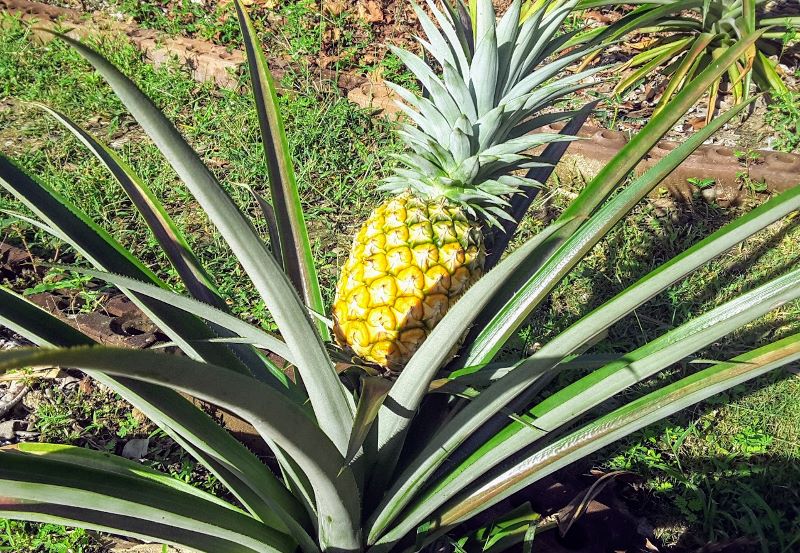Pineapple is a bromeliad (Ananas comosus), and can be easily grown in your home garden if you have a warm climate and decent sun exposure. Pineapple is an extremely hardy plant and can tolerate a wide range of weather and soil conditions.
Indigenous to South America, the pineapple became known to the wider world 500 years ago and rapidly became a commercial crop in many warm climate zones around the world.
Pineapples are not generally grown from seed. Rather, they are grown from suckers & slips collected from a mature plant, or by planting the crown of a pineapple fruit.
Planting Pineapple Crowns
You will see many articles posted to the Internet explaining step-by-step how to grow a pineapple from the crown. I have tried many variations, from allowing them to root in a jar of water to drying out for several weeks. The truth is, the different techniques all work.
I have found that pineapples grow so easy that the details of how or where you plant do not matter so much. If you want a good tasting pineapple, plant the crown of a pineapple you enjoyed eating. If you want a vibrant healthy plant, start with a vibrant healthy crown.
Time needed: 500 days
How to grow a pineapple at home from a crown
- Remove the crown from a pineapple
Choose a pineapple with a healthy, uncut, crown. Twist (do not cut) the crown and it will easily come free from the body of the pineapple.
- Remove the lower leaves from the crown
The leaves will easily peel off. The leaves overlap where they attach to the body of the sucker, so just tug on the outermost leaf first. Typically you will want to remove the leaves from the lower 3rd of the crown, but generally try to strike a balance between leaving a healthy, leafy crown, and have enough of the plant to root under the soil.
- Dry your pineapple crown
Leave the crown for a few days in a dry, shaded area. This step is not critical, but ideally you allow the base of the crown to dry out before planting (it will initially have some fresh fruit attached). Don’t worry if you leave it drying for quite a long while, it will survive in this state for weeks.
- Planting your pineapple
Don’t worry too much about soil conditions. Good sun exposure is more important. Although somewhat flood resistant, pineapple plants have a preference for good drainage, so build a small mound of soil and plant firmly.
- Wait for your pineapple to flower
On average it will take 18 months to produce fruit from a pineapple crown. The exact time depends on when you plant in relation to the flowering season. Also, a pineapple plant in poor condition (too shaded, diseased, smashed by lawnmower, etc.) may take an extra year to gather its strength for flowering.
- Harvest your Pineapple
Your pineapple will change color and have a strong, sweet smell when it is ripe. You can leave it in your garden until it is completely ripe as the plant has natural defenses against birds. (at some point ants may become interested though). Cut through the stalk below the base of the pineapple fruit. You can twist the crown off this fruit and start the whole propagation cycle again!
- Post-Harvest Management
A lot of people believe that the pineapple plant will die after the fruit is harvested. This is not strictly true. The leaves will die off slowly, but a healthy plant will often produce new growth at the top. If you get more than 1 sucker regrowing, you can leave the healthiest sucker in place, the others can be removed and planted elsewhere. Suckers can also grow from the base of the plant – remove these and replant also.
Preparation for Planting a Pineapple Crown
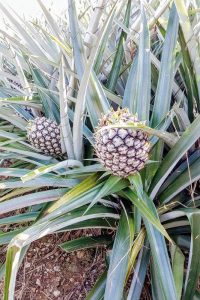
First you will need to select a pineapple with a healthy looking crown. Unfortunately, it is common practice to cut off most of the crown or completely remove the crown for packing and transport.
When you manage to find some pineapples with full crown intact, buy as many as you can eat and plant several at once if you have enough space in your garden.
To remove the crown, grasp it firmly (be careful of the sharp serrated leaves) and twist. The crown should come away easily from a ripe fruit. If you are not confident doing this with bare hands you can use a gardening glove, oven mitt, or tea-towel covering the hand that is grasping the crown.
The reason you should twist the crown rather than cutting it from the fruit is that the crown extends a short way down inside the fruit. This base of the crown will almost always have small roots attached already, and your plant survival and growth rate is vastly improved with the base intact.
You should probably allow the base of the crown to dry for a few days, as root rot is a real thing for pineapples. On the other hand, it probably does not matter, especially if you plant more than 1 pineapple crown.
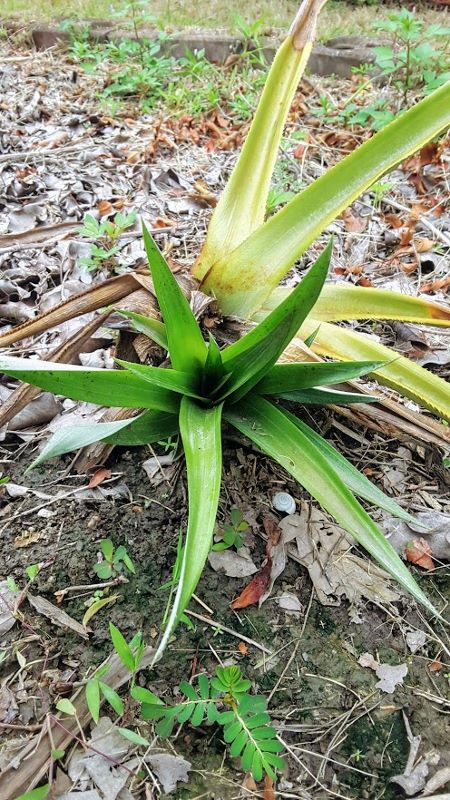
Planting Pineapple Suckers
Commercially, pineapple is planted using slips & suckers harvested from mature pineapple plants. This allows for a shorter time to maturity for the new plant compared to planting a crown.
If you live in a pineapple-producing region you may be able to buy suckers in bulk quantity from a farm. Just be aware that good canning cultivars are not necessarily good for producing fresh fruit.
In my experience, commercial farmers are uninterested in selling suckers when the wholesale price of pineapple is high.
At the moment we have low pineapple prices in my area and farmers are selling excess suckers road-side (although they are holding back the best quality suckers for their own use).
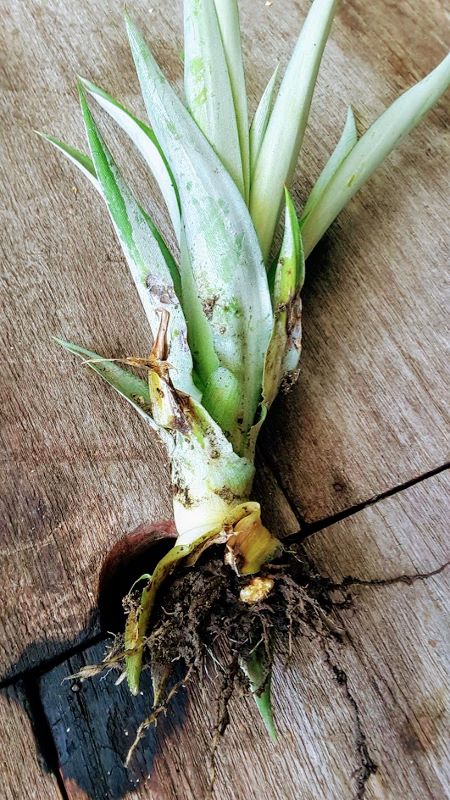
What is a Pineapple Sucker?
A pineapple sucker, also known as a pup, is a shoot that emerges from within the leaves of a mother plant, or from the butt of the plant. Suckers/Pups look like miniature pineapple plants, and can in fact be harvested and replanted.
Suckers / Pups are also capable of producing fruit while still attached to the mother plant. When this occurs, they are referred to as ratoon suckers, and the resulting fruit is called a ratoon crop.
What is a Pineapple Slip?
A pineapple slip is a shoot that emerges from a pineapple plant and is capable of flowering and fruiting when replanted. Slips are distinguished by their long leaves (relative to suckers/pups) and generally grow from the upper part of the mother plant (and often from the base of a fruit).
Other Methods of Pineapple Propagation
It is possible for a buried plant to root and regrow. Even cuttings taken from the fruit stalk can be propagated in this way.
I have on several occasions mulched over old uprooted pineapple plants or attempted to compost them, only to discover they have re-rooted and produced pups several months later.
Pineapple Plant Maintenance
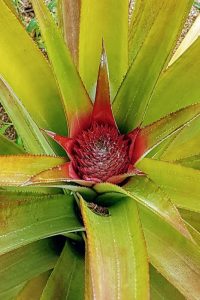
Pineapple plants are largely happy to just thrive on their own. As long as they get a reasonable amount of water at some point in the year, they can endure long periods of dry.
You need to be a little careful when weeding. Even when wearing garden gloves, it is not a good idea to thrust your hand between the leaves. The sharp serrated leaf edges can easily draw blood, and quite badly if you force your hand past quickly.
The technique I use involves moving one hand slowly at ground level under the lowest leaves. You can then fold the leaves upwards and in towards the center of the plant. With your other hand, you then have much better access for removing weeds.
On commercial plantations, they usually feed pineapple with nitrogen fertilizers. In an organic home garden you can apply compost and mulch instead.
It is a good idea not to drop compost and other debris into the center of the plant, especially when it is flowering. On the other hand, a small amount of dirt is unlikely to cause major problems.
Pineapple plants are extremely tolerant of transplanting, so go ahead and move your plant if you want to. You can even use the opportunity to pull some old dead leaves away from the butt and plant a little deeper in the new location.
Further Information on Growing Pineapples
For a more detailed discussion of the history, commercial production and common cultivars, see:
https://hort.purdue.edu/newcrop/morton/pineapple.html
Morton, J. 1987. Pineapple. p. 18–28. In: Fruits of warm climates. Julia F. Morton, Miami, FL.

